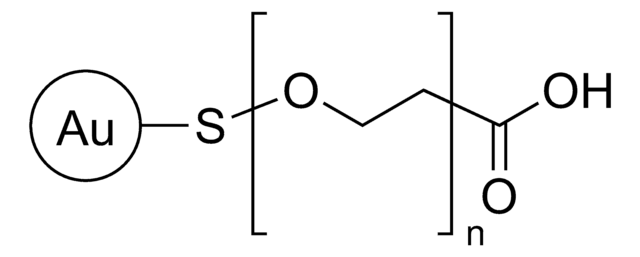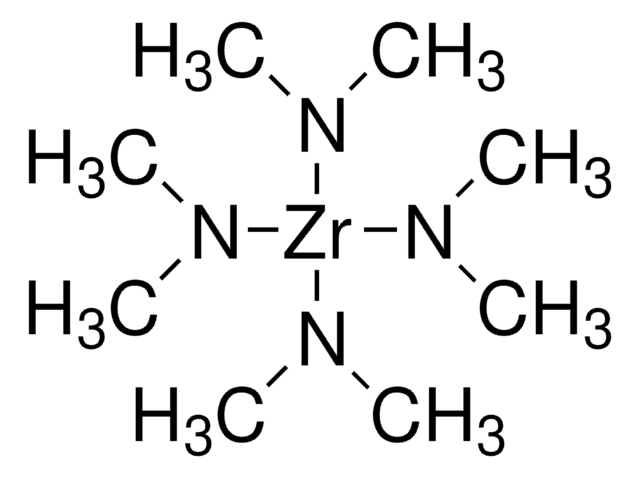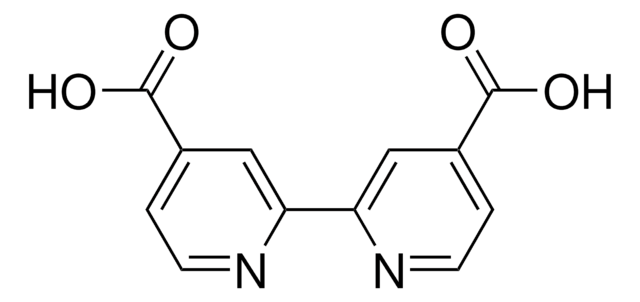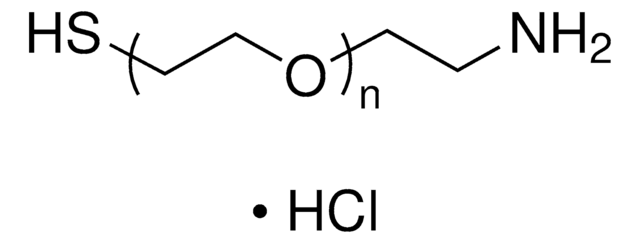推薦產品
一般說明
Gold nanoparticles (AuNPs) ranging from 2-200nm in diameter find applications in diverse fields. They show excellent biocompatibility and attractive physicochemical properties. Poly (ethylene) glycol (PEG) surface coatings on gold nanoparticles help in the reduction of protein adsorption, reduce nonspecific interactions with cells and greatly improve the pharmokinetics of these nanoparticles and reduce aggregation of the nanoparticles. PEG layer density depends inversely on the AuNP curvature. Denser coating was possible on smaller AuNPs. Carboxylic acid functionalized GNPs form conjugates with various protein molecules due to the electrostatic attraction between the negatively charged carboxylate groups and positively charged amino groups of protein. Since it adheres to cell membranes, it may find use in cellular and intracellular targeting in targeted drug delivery applications and also used in biodistribution studies.
應用
Several other specific applications have been listed below:
- Since they adhere to cell membranes, AuNPs may find use in cellular and intracellular targeting in targeted drug delivery applications and may also be used in biodistribution studies.
- AuNPs may also be used in photothermal therapy and radiotherapy.
- AuNPs ranging from 10 to 250 nm, were studied to have been absorbed primarily by liver and spleen, when injected intravenously in rats.Whereas, 10 nm nanoparticles were distributed more broadly into various organs.
- Carboxylic acid end-groups bind with various proteins and hence are used in targeted drug delivery and gene therapy.
功能化颗粒已被广泛用于研究纳米颗粒的细胞摄取和靶向药物递送。
儲存類別代碼
12 - Non Combustible Liquids
水污染物質分類(WGK)
WGK 1
閃點(°F)
Not applicable
閃點(°C)
Not applicable
Alexandre Albanese et al.
ACS nano, 5(7), 5478-5489 (2011-06-23)
Aggregation appears to be a ubiquitous phenomenon among all nanoparticles and its influence in mediating cellular uptake and interactions remain unclear. Here we developed a simple technique to produce transferrin-coated gold nanoparticle aggregates of different sizes and characterized their uptake
Nishima Wangoo et al.
Journal of colloid and interface science, 323(2), 247-254 (2008-05-20)
We report a novel strategy for the synthesis of aqueous stable, carboxylated gold nanoparticles (GNPs) by using glutamic acid as the reducing agent. The ratio of chloroaurate ions, AuCl(-)(4) to glutamic acid was optimized in the reaction medium to obtain
Gold nanoparticles for the improved anticancer drug delivery of the active component of oxaliplatin.
Sarah D Brown et al.
Journal of the American Chemical Society, 132(13), 4678-4684 (2010-03-17)
The platinum-based anticancer drugs cisplatin, carboplatin, and oxaliplatin are an important component of chemotherapy but are limited by severe dose-limiting side effects and the ability of tumors to develop resistance rapidly. These drugs can be improved through the use of
Xiao-Dong Zhang et al.
International journal of nanomedicine, 6, 2071-2081 (2011-10-07)
Gold nanoparticle toxicity research is currently leading towards the in vivo experiment. Most toxicology data show that the surface chemistry and physical dimensions of gold nanoparticles play an important role in toxicity. Here, we present the in vivo toxicity of
Timothy A Larson et al.
ACS nano, 6(10), 9182-9190 (2012-09-27)
Polyethylene glycol (PEG) surface coatings are widely used to render stealth properties to nanoparticles in biological applications. There is abundant literature on the benefits of PEG coatings and their ability to reduce protein adsorption, to diminish nonspecific interactions with cells
文章
The recent emergence of a number of highly functional nanomaterials has enabled new approaches to the understanding, diagnosis, and treatment of cancer.
The recent emergence of a number of highly functional nanomaterials has enabled new approaches to the understanding, diagnosis, and treatment of cancer.
Biomaterials science involves the design and fabrication of smart materials for studying, directing, or mimicking biology. For successful integration of biomaterials in biological research, a meaningful understanding of biological systems is required.
我們的科學家團隊在所有研究領域都有豐富的經驗,包括生命科學、材料科學、化學合成、色譜、分析等.
聯絡技術服務







